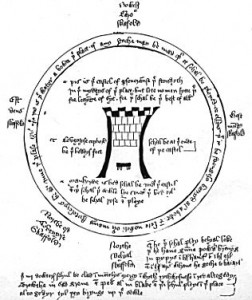With Christmas coming up, I am reminded that a variety of plays and musicals take place during this time. Let’s say you need a present as a prop. Is it wrapped? What kind of paper would you use? A lot of these answers depend on the specifics of the text: the time period, setting, class and ethnicity of the characters who are involved with the present. Still, it’s nice to have a rough timeline of the various technologies and customs involved with the wrapping of presents in Western culture.
I’ve organized this timeline in reverse order. Merry Christmas!
1970s-80s – Wrapping paper begins to have movie and television tie-ins, with characters printed on the paper (“A History of Gift Wrap” by Mac Carey).
1950s-60s – Wrapping paper patterns become more realistic (Carey).
1939-1945 – During World War II, gift wrap was not rationed to keep morale up (Carey).
1930s-40s – Wrapping paper patterns become more stylized due to influences from Art Deco. Some more popular patterns include ice skaters, snowflakes, Christmas trees, and candles (Carey).
1930 – “Scotch” tape is invented. Check out the Tape Innovation Timeline at the Scotch website for more milestones in transparent tape, as well as pictures of vintage tape dispensers and packaging. Before this, gifts were tied up with string and sealing wax (Carey).
1917 – According to the Hallmark site, Joyce Clyde Hall and his brother, Rollie, invented modern gift-wrap in their Kansas City, MO, store. When they ran out of their solid-colored gift dressing during the peak of the Christmas season, they began substituting the thicker French envelope liners for wrapping presents. It sold so well they began printing their own. Previous to this, they sold white, red and green tissue and one holly pattern for gift-wrapping.
1912 – Cellophane paper is used to wrap Whitman’s candy. Sales of cellophane triple between 1928-1930 following the introduction of moisture-proof cellophane. It is used as wrapping paper, either alone or in conjunction with regular paper.
Early 20th Century – According to the Hallmark press room, gifts are wrapped in tissue or plain brown paper during this time (an archived version of the page is available at the Internet Archive).
1890 – Flexography, a printing process using a flexible relief plate, is patented. It makes possible the mass production of a foldable, stiff paper which could be printed with colored inks (Carey).
1881 – Stockings hung either by the fireplace or bed and filled with presents were in common usage in England at this time (BBC, The Ten Ages of Christmas).
1874 – Louis Prang, the “father of the American Christmas card,” becomes the first printer to offer Christmas cards in America.
1857 – Joseph Gayetty introduces toilet tissue to the world (The Toilet Paper Encyclopedia). Tissue paper springs from this invention. In 1863, Ebenezer Butterick chooses tissue paper for his newly-invented graded sewing patterns, implying that it was somewhat widely available by that time. The use of tissue paper for gift-wrapping soon follows.
1843 – A Christmas Carol, by Charles Dickens, is published. He describes presents which are wrapped in brown-paper parcels in the past (circa 1836).
1843 – Sir Henry Cole of London commissions the first commercial Christmas cards from John Callcott Horsley (Inverloch Historical Society, January 2004 newsletter).
Victorian Period (1837-1901) – Wrapping paper is decorated similar to the Christmas cards of this era. Flowers, cherubs, and birds are among the more popular patterns (Carey). “Christmas papers were intricately printed and ornamented with lace and ribbon. Decorated boxes, loose bags, and coronets bore cutout illustrations of Father Christmas, robins, angels, holly boughs and other seasonal decorations” (“How is wrapping paper made?” by Gillian S. Holmes)
1823 – First publication of “A Visit from St. Nicholas“, aka “‘Twas the Night before Christmas”. St. Nicholas fills stockings hung by the chimney with toys. There is no mention of presents under the tree, or whether anything is wrapped.
1804 – First advertising for Christmas gifts in America (South Main Preservation Society).
19th Century – Gifts were sometimes presented in decorated cornucopias or paper baskets (Carey).
1745 – We have a mention of “brown or wrapping paper” used “to wrap up Goods, therefore called Shop-Paper” (The Harleian miscellany, by William Oldys, pg 339).
1509 – Earliest-known sample of wallpaper. It was used only briefly as gift-wrap because it cracked and tore too easily when it was folded (Hallmark’s History of Gift Wrap).


